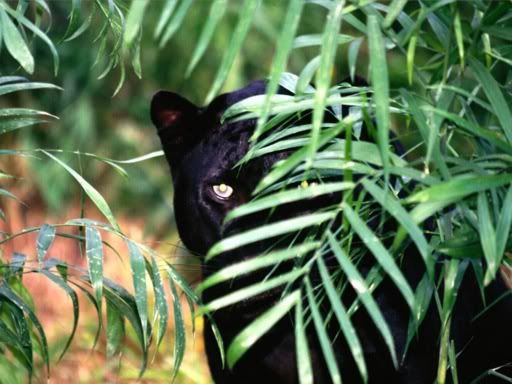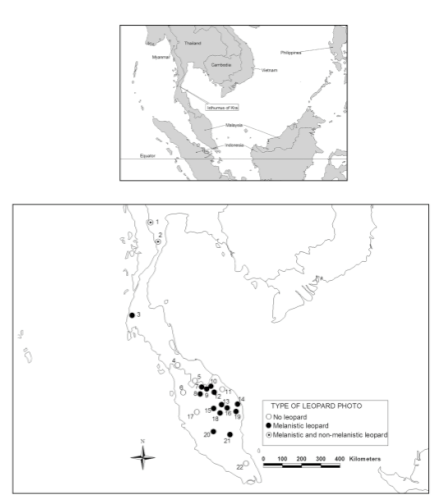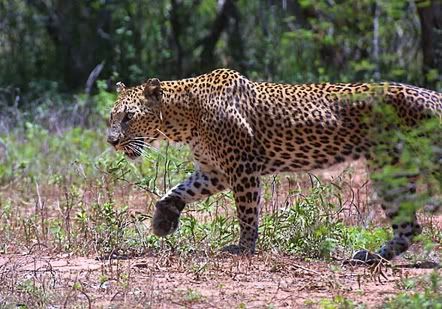If there is one animal that that can be said to symbolize the mysterious wildness inherent in the deep jungle, it's the panther. The black coats seen in these animals have inspired myths and legends across many cultures throughout the ages. However, such a beast, as an independent entity, does not exist. Instead, these popular animals are in fact black morphs of more commonly known cats. Such coat colorings have been reported in the jaguar of the Americas and, more famously, in the leopard. However, in most areas melanism (the more formal name for such a coloring), a recessive trait in leopards, is a relatively rare occurrence. One remarkable exception can be found in the Malay Peninsula, a thin region of land comprising pieces of both Thailand and Malayasia found just south of the Isthmus of Kra.
Reports of a bounty of melanistic leopards in this area have been found as early as the 19th century. However, a scientific assessment of the status of these creatures is a remarkably difficult process. Leopards are solitary animals and incredibly reclusive by nature. For somebody to so much as catch a glimpse of a leopard is a fantastically rare event. As such, to assess the frequency of color patterns in a broad geographic region, searching for the animals on foot is not an option. Instead, an international team of scientists have opted for a higher-tech option: infrared imaging systems. Strategically placed, these cameras have been proven to be exceptionally useful for capturing images of otherwise elusive wildlife. To determine the frequency of this color pattern, the researchers pooled together data from camera trapping projects in over 22 separate locations throughout the Malay Peninsula and the regions bordering it to the north. Taken together, they recorded some 474 images of leopards over 42,565 collective camera trapping nights. What they found was quite remarkable.
Of the 22 camera trapping sites in the study, 16 captured images of leopards. The melanistic morph was found in all camera trapping sites that recorded leopards, but the spotted morph was only found in those areas north of the Isthmus of Kra. This suggests that though one cannot conclude that spotted leopards are entirely absent with the present dataset (indeed, they have been previously reported in the area), they are rare enough that it's likely that the recessive allele for melanisim is 'nearly fixed' in the population. One possibility that could explain the prevalence of melanistic leopards is through genetic drift, wherein genes are shuffled about the population, and through chance, change in frequency. The authors ran a variety of scenarios, using different population sizes to determine the amount of time required for genetic drift alone to account for the unique status of the Malay leopards. These ranged from 1,100 years with a population of 100 (which would have lead to a severe bottleneck) to 100,000 years with a population of 5,000, with a myriad of scenarios in between.
Therefore, the question remains--to what degree is the frequency of melanism in the leopard population due to genetic drift (which would require a high amount of geographic, and therefore reproductive isolation), and to what degree was the near fixation due to natural selection? Genetic studies of tigers have suggested that gene flow has indeed been very much reduced between the two areas, and as such it seems likely that genetic drift had at least some play in this evolutionary event. Suggested causes for these genetic bottlenecks include the rise of sea levels caused by the end of the last ice age and the volcanic winter that would have occurred when Mount Toba erupted 74,000 years ago. These bottlenecks would have detectible signatures in the genes of the Malay leopards, and future genetic studies will help test for such a possibility. However, there have been selective benefits of melanism postulated, including increased camouflage in densely forested environments. This too may have helped meld the leopard population of the Malay Peninsula.
The authors conclude that "it is likely that both genetic drift and natural selection have been involved at different stages in the history of leopard melanism, providing a unique system for studying the adaptive genetics of carnivore coloration." Surely, many surprises and wonders await in the study of Malay's secretive leopards



